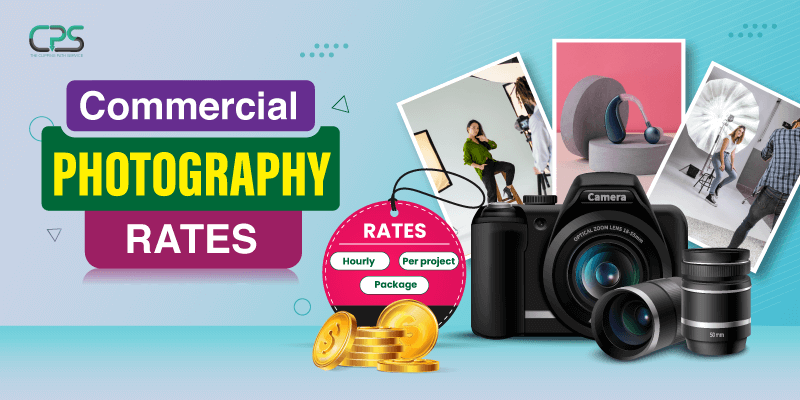
Commercial Photography Pricing: E-Commerce Sellers Should Know
Commercial photography pricing can seem excessive, but it’s crucial to understand what goes into it. As a client, why do these services come with such a high price tag? Let’s break it down.
Firstly, experienced photographers invest years to learn the techniques and grow their businesses in the competitive world of commercial photography. They battle to set the correct prices that reflect their expertise and the quality they deliver.
Several factors contribute to the cost of a commercial photography session. Photographers consider their experience, reputation, and extensive pre and post-production work. These elements ensure the final images meet the highest standards and showcase your products or services in the best possible light.
Now, the big question: Should you go for a cheaper alternative? While budget options might seem tempting, you must weigh the potential impact on quality and your brand’s image. This article will explore how photographers structure their pricing and help you decide if cutting costs is worth the risk.
Table of Contents
ToggleKey Factors Influencing Commercial Photography Pricing
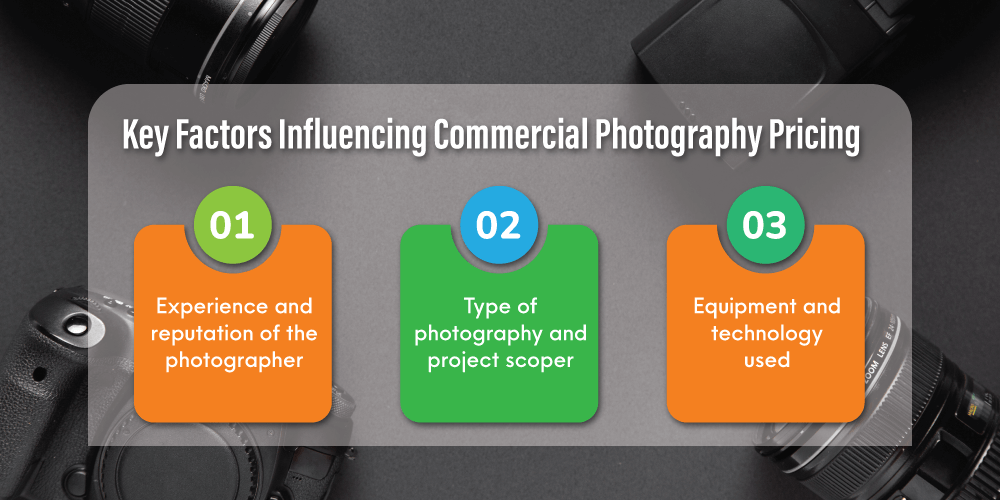
Many photographers charge a flat rate to their clients. Sometimes, this works, but most of the time, the client reacts negatively and runs away.
It means that clients still have the budget. People only give you money when you give a proper explanation. The best thing you can do to ensure your commercial photography business stays successful is to break down costs. In commercial photography pricing, photographers count some key factors. These are:
Experience and reputation of the photographer
A long, successful career and a good reputation as a photographer do not come for free, so it will heavily influence the pricing of a commercial photography session.
Type of photography and project scope
Different types of commercial photography have different pricing, and the same rate cannot be used for every kind of photography.
Equipment and technology used
This factor complements the previous one. Different types of photography require different equipment and technology, so the pricing must also be different.
Common Pricing Models in Commercial Photography
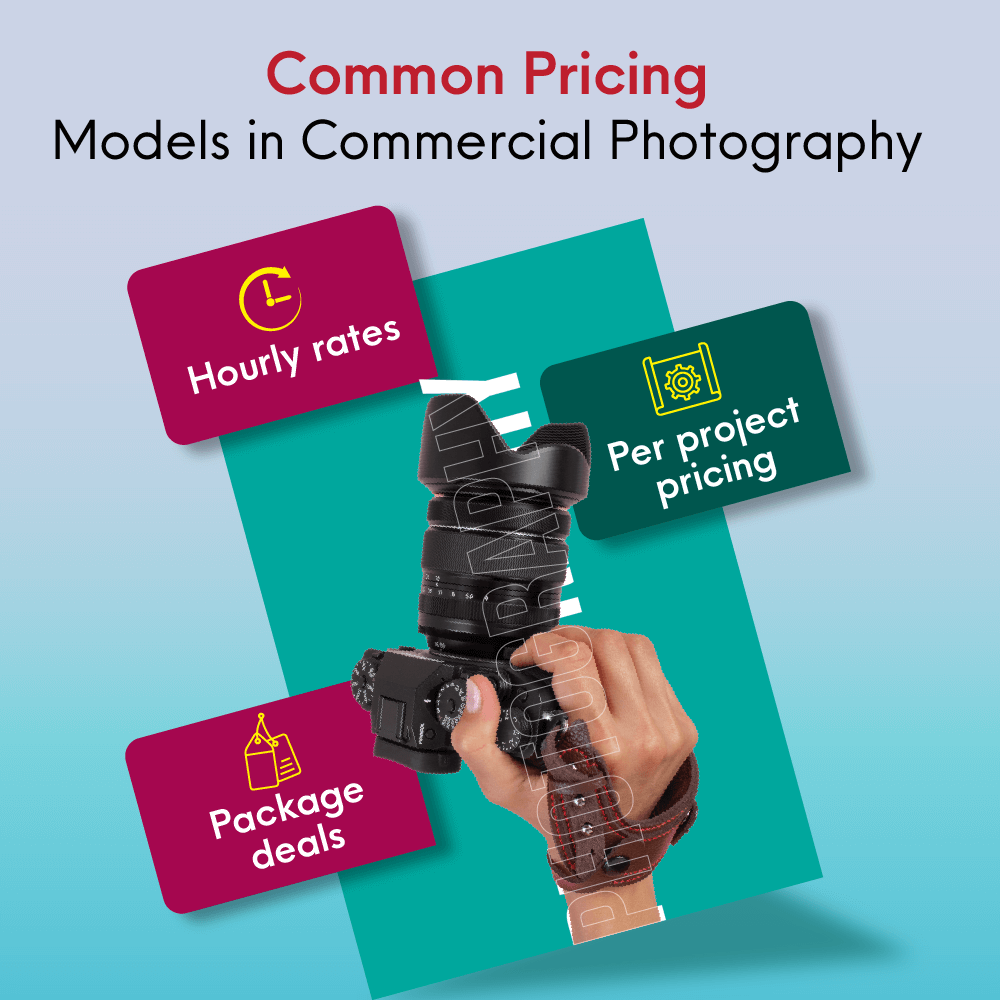
The pricing models of commercial photography are three types:
Hourly rates
Many photography agencies use hourly rate models for their services. In this model, the client pays you hourly. That means they pay you only for the hours you spend completing their project. So you don’t need to spend an extra second on the project, and clients also have the luxury of booking you for hours if they have a short project.
Per project pricing
You can set the pricing per project if a client has multiple projects. In this model, clients don’t need to keep an eye on the clock. They can give the project and share a deadline. If the photographer agrees, they will complete and deliver the project within the deadline.
Package deals
Last but not least, photography agencies typically offer package deals to their clients. The packages can be based on product types, such as shoe or clothing photography packages.
Detailed Breakdown of Pricing
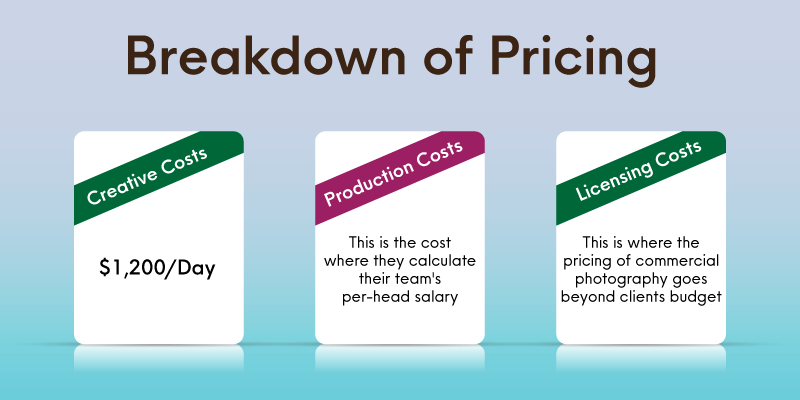
Now that we know commercial photography can have several pricing models, let’s discuss the breakdown. The three major points of this breakdown are Creative costs, Production Costs, and Licensing Costs. Below, I have described all of these.
-
Creative Costs
First of all, this is not the cost of your image quality. Creative costs are the costs of the photography session and their paycheck. Generally, a professional commercial photographer charges $1,200 per day.
They use the below formula to find out their daily rate:
(Operational Cost + Income) / Shooting Days = Daily Rate
When they charge on a session basis, they use the below formula to find the cost:
(Daily Rate / Number of Sessions Per Day) x 1.5 = Session Cost
-
Production Costs
This is the cost where they calculate their team’s per-head salary, travel expenses, and equipment rental. The more assistants they need to complete your project, the more expensive the service will be.
-
Licensing Costs
This is where the pricing of commercial photography goes beyond the client’s budget. As a client, you might think that as you pay the photographer to work for you, all the images are yours.
After paying the photographer, you can use the image anywhere you want. But it’s not. Photographers charge a licensing cost based on the places you use that image. It can be on your packaging, billboards, or magazines.
They can also make this term available for lifetime use. Yes, I know it doesn’t make sense to you or other clients, but it’s a crucial aspect of the creative field that you can’t ignore.
Let’s give you an example of how much the licensing costs can be. Suppose you are a shoe brand that needs commercial photography. So, according to the formula of licensing costs, your photographer will charge a percentage from you for using the images on every package, every billboard, and every magazine.
For a clear view of your cost, here is a sample pricing list:
|
Your Spending |
Their Percentage |
|
$1-1,000 |
15% |
|
$1,000-5,000 |
10% |
|
$5,000-50,000 |
5% |
|
$50,000-250,000 |
2% |
|
$250,000+ |
1% |
Cheap Alternative You Should Try
The pricing of commercial photography is huge, and with the licensing cost, it goes on for an extended period. As a client, if you want to avoid being dragged for so long, I can suggest a cheap alternative.
Before revealing the name, I want to share my thoughts on something innovative and futuristic: 3D services. 3D is the future of everything, including commercial photography. 3D images are a thousand times more appealing than typical product images. Nowadays, many post-production houses offer premium-quality 3D imaging services at a very competitive price.
The CPS is one of the top players in this rare category. We have years of experience, specifically in the 3D genre. With dedicated teams for each service and a three-step quality assurance process, the quality of our output is unmatchable, and our price is unbeatable. With typical commercial photography services in the USA, the price for a project can go from $3k to $10k+. In contrast, in the CPS, the starting price is just $10.
Below, I have shared the pricing table of all our 3D services.
Pricing Table:
Service | The Clipping Path Service |
3D Modeling | $25 |
3D Texturing | $10 |
Silo Rendering | $10 |
Architectural Rendering | $89 |
Product Animation | $99 |
Lifestyle Rendering | $79 |
So you can see that opting for our service is way cheaper than going with the typical product photography. And if you have doubts about the quality, I suggest you take our free trial and decide. We work 24/7 to ensure the professional quality of our 3D services. We have the finest expertise in the house.
What are the Ideal Shopify Image Sizes?
Shopify gave a boundary for the product image size that may upload to the stores. According to Shopify’s product image requirements, the image size should be between 4472 x 4472 pixels with a file size of up to 20 MB.
But we can’t say this is the ideal size for Shopify product images because these are very high-resolution images and using images with large sizes can slow down your store. Forget about Shopify, the theme you will use to create your Shopify store also has its own product image requirements.
The ideal Shopify image sizes are actually the images that will look impressive and also the size of the file won’t affect the loading time. That means according to your taste and need you to have to optimize your Shopify product image size, keeping them between the boundaries.
How to Get Your Shopify Image Sizes Picture Perfect?
If you want to get your Shopify images size picture perfect, then you have to follow the requirements and be consistent with the image size you use in your store.
Whether you create a product image for slideshow, collection, or product listing, be consistent with every type of photo you use in your store. Optimize your image size according to the policy and maintain the same quality for different screen sizes like smartphones or tablets. Doing this the visitors will feel like the continuity across the platform and screens.
How Shopify handles images?
After uploading a product image to Shopify, it does some minor image compression by itself in its server. Shopify compresses the image into a 72dpi version. You can upload your product images in the 72dpi version, which will allow your product image to avoid Shopify’s compression process.
What is the best size for eCommerce product images?
For different e-commerce platforms, product image requirements are slightly different also, but requirements for the image file size are not so different after all. The reason is file sizes increase the loading time of your online store and this can have a large impact on your business.
To increase the client conversion rate your store needs to load faster, but to do so if you upload a low-quality image can affect your business in the same way. The ideal image file size for eCommerce stores are 72 Kb.
Yes, I know it is significantly less than compared to the high resolution of product photo retailers shoot and produce. To meet the sweet spot where your image won’t exceed the ideal size and also look perfect, but with specialized image resizing by the hand of professional experts, you can achieve the target.

Bordie Capron
Author
“Bordie Capron is a Sr. Content Maker who is working in The Clipping Path Service an US-based image and video post-production company for over 7+ years. She completed her degree in graphic designing and worked as a graphic designing expert for several years. She always loved writing”
Categories
- Image Guidelines (12)
- Post Production (8)
- Pre Production (27)
- Review (16)
- Tips (51)
- Tutorial (18)
Recent Posts
Quick Response
Email:
cs@theclippingpathservice.com
Hotline Support:
Mobile: +1 (718) 717-2362

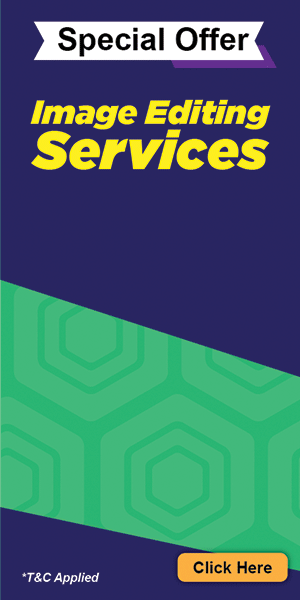
No Comments